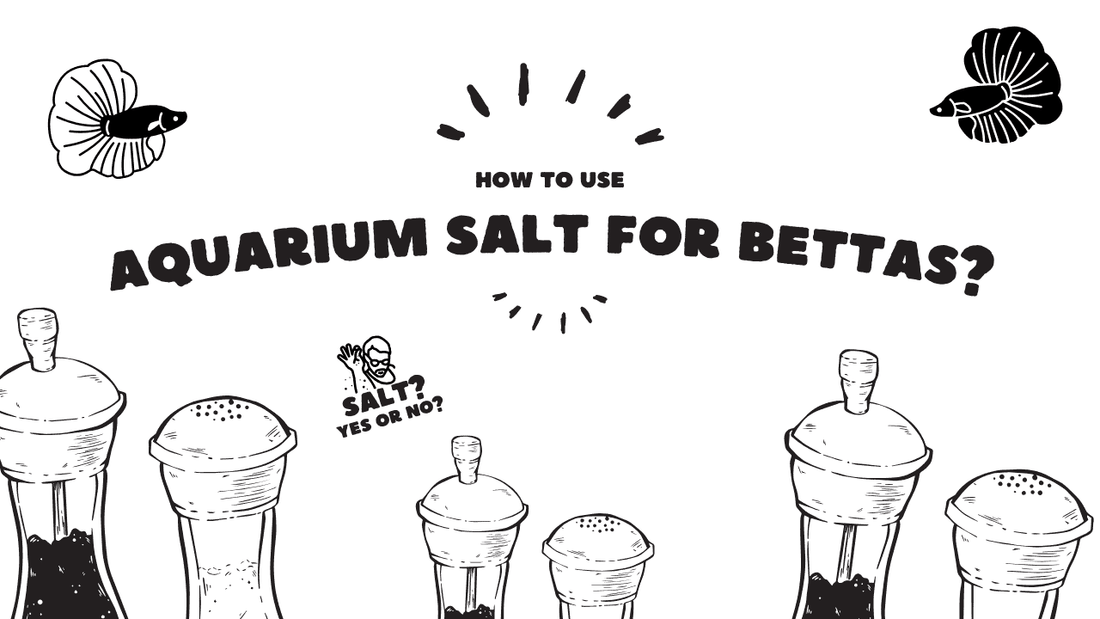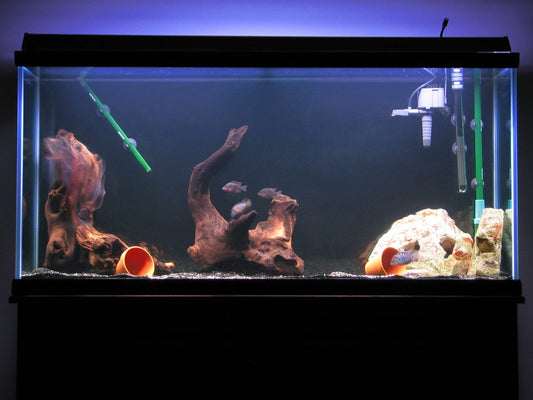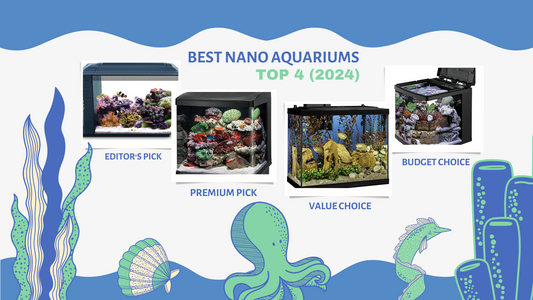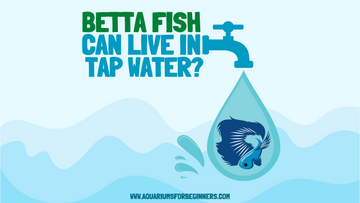How to Use Aquarium Salt for Bettas? (2024)

Your betta fish is looking a bit under the weather, maybe even swimming with a limp fin. You’re like a worried parent outside an ER, wondering how to get that bright shimmer back into their scales. Enter, the drama of fish health! (Yep, it’s a thing).
Sure, Bettas are feisty, little warriors of the aquatic world, but even they get the blues. When your betta throws shade instead of showing shade, it's high time for a health check.
You’ve trawled the deep depths of fish forums, from the murky waters of random Reddit threads to the vast ocean of YouTube. The debates rage on: "To salt or not to salt?"
Fear not, salt-sprinkling aquarist! In the galaxy of betta health, aquarium salt shines like a North Star. It’s the secret sauce (without the sodium overload) to rejuvenate those fins and have your betta breakdancing like it’s 1999.
So, grab your snorkel and flippers; we're diving in! The ultimate guide on 'How to Use Aquarium Salt for Bettas?' awaits.
Ready for the plunge? Of course, you are. Dive right in! 🐠🌊🧂

Benefits of Aquarium Salt
Aquarium salt for betta fish, made primarily of sodium chloride, isn't your regular table salt. Its roots trace back to evaporated seawater, and it boasts benefits that your standard culinary salt wouldn't dare dream of. First and foremost, it helps reinforce the fish's slime coat, a protective layer on the fish's skin, giving it a better defense against parasites and bacteria.
Here's a concise breakdown of the benefits of aquarium salt for bettas:
- Strengthens Slime Coat
- Improves Gill and Kidney Function
- Deters Pathogens
Another benefit? Aquarium salt can improve gill and kidney function in freshwater fish by assisting them in expelling toxins. When dissolved, the oxygen and hydrogen molecules in the salt break down, creating an environment that can deter certain pathogens.

Top-Rated Aquarium Salts for Betta Fish in 2024
In a hurry? I recommend API AQUARIUM SALT
API AQUARIUM SALT

"Made from evaporated sea water". Sounds fancy, right? API AQUARIUM SALT promotes healthy gill function and reduces the impact of stress on our aquatic buddies. It's ideal for freshwater aquariums and is known to aid in the healing of fish wounds.
Pro Tip: When using API Aquarium Salt, ensure you're dosing as per the specific needs of your tank and its inhabitants. It's not about turning your tank into a salt mine but adding just the right touch to enhance your betta's health.
Pros:
- Elevates natural fish electrolytes
- Effective in treating a variety of fish diseases
- Non-toxic to common aquarium plants and fish
- Encourages healthy gill function
Cons:
- Overuse can be detrimental to fish health
- Not suitable for long-term use in certain freshwater setups
✅ Short Review from a Verified Customer: “I swear by API Aquarium Salt! Noticed my betta acting sluggish and after a short treatment, he's back to his vibrant self. Just remember to follow the instructions to the letter, and you're golden. It's a must-have in my fish care arsenal.”
Fritz Aquatics A+ Aquarium Salt

If API was the cool senior in high school, Fritz Aquatics is the quirky exchange student everyone loves. Crafted with marine fish and other fish species in mind, it's also great for freshwater tanks. Fritz offers a balanced blend that supports a fish's overall health, especially that precious slime coat.
Pro Tip: This salt formula isn't just a one-trick pony; it's brilliant for general fish health, and even better when used as a short-term treatment during specific disease outbreaks.
Pros:
- Boosts slime coat production, giving an extra layer of protection
- Supports healthy gill function and respiratory efficiency
- Aids in healing skin wounds and torn fins
- Fast-acting treatment for various diseases
Cons:
- Consistent long-term use not recommended without monitoring
- Dosage precision is key for effectiveness
✅ Short Review from a Verified Customer: “Fritz Aquatics A+ Aquarium Salt was a game-changer for me. My betta had some fin tears and after using this salt for a week, I could see a marked improvement. It’s not just salt; it’s peace of mind in a bottle. Highly recommend for any betta parents out there!”

Aquarium Salt Treatment
You wouldn't season a soup without tasting it first, right?
Similarly, there's an art to adding aquarium salt. The amount varies based on the freshwater fish tank's needs. Treating your tank with the right dose can be the difference between a rejuvenated, vibrant betta and, well... a salty situation.
Let's dive right into the step-by-step guide:
Check Your Water: Before you even consider adding salt, test your water parameters. This gives you a clear baseline of your tank's current condition.
Choose Your Salt: Whether it’s API Aquarium Salt or Fritz Aquatics A+ Aquarium Salt, ensure you’ve got a reliable and trusted product.
Measure Accurately: ⚖️ Use a measuring spoon and always follow product-specific recommendations. Usually, a teaspoon of aquarium salt per 5 gallons of water is a good place to start, but always refer to the product label.
Dissolve Before Diving: 🌀 Always pre-dissolve the salt in a container with some tank water. This ensures an even distribution when you add it to the tank.
Slowly Add the Salt Solution: Pour the dissolved saltwater solution slowly and evenly around your tank.
Observe Your Betta: 👀 After adding the salt, keep a close eye on your betta for the next few hours. If they seem stressed or uncomfortable, consider doing a partial water change.
Monitor and Adjust: Regularly test the water parameters to ensure everything remains balanced. If the need arises, repeat the treatment as instructed by the salt product label.
Limit Duration: Remember, while bettas can benefit from salt treatments, it shouldn't be a long-term thing. Typically, a week or two is the max duration for a salt treatment, unless otherwise specified.
Plant Caution: 🌿 Some plants may not appreciate the salt. If you have a heavily planted tank, consider using the salt treatment in a quarantine or hospital tank.
Regular Maintenance: After the salt treatment, continue with your regular tank maintenance routine. This includes regular water changes and periodic water testing.
REMEMBER: when using aquarium salt, think of it as a therapeutic treatment and not a daily supplement. Over-relying on it could disrupt the balance of your tank. But when used judiciously, it's a fantastic tool in your aquarium toolkit! 🧂👌🏼

How and When to Use Aquarium Salt to Treat Betta Fish Diseases
Sometimes, even in the best-maintained tanks, poor water quality or unforeseen circumstances can cause our betta buddies to fall ill. But before you start dumping in the salt, let's discuss how to appropriately dose based on the ailment your betta might be facing.
Minimum Dosage
Think of it as adding a pinch of salt to your meal. For milder conditions like stress from a recent move, or slight discoloration, a minimum dosage might do the trick.
Add about one tablespoon for every five gallons of aquarium water.
Moderate Dosage
For more concerning issues like minor fin rot, fungal infections, or the beginning stages of ich, you might need a little more kick. Go for two tablespoons for every five gallons.
This slightly elevated salt level can help combat these ailments by boosting your betta's natural slime coat and discouraging fungal and bacterial growth.
Maximum Dosage
Sometimes, you've just got to bring out the big guns. For those not-so-fun experiences with severe bacterial infections, persistent ich, or extreme stress conditions, three tablespoons for every five gallons is the recommended shot.
NOTE: this is kind of like antibiotics for humans; you don't want to jump straight to the max unless it's genuinely necessary.
Identifying and Treating Betta Diseases with Aquarium Salt:
- Ich (White Spot Disease): Small white spots, similar to grains of salt. Betta may also scrape against objects. Treat with moderate to maximum salt dosage and increase tank temperature slightly for a few days.
- Velvet: A rusty, gold-colored dust appears on the betta, often leading to clamped fins and loss of appetite. Early stages can be treated with moderate salt dosage, but advanced cases might require the maximum punch.
- Fin Rot: Fins look torn or have a ragged appearance, often with a white or black edge. A moderate salt dosage can often help, but always ensure the water quality is top-notch and remove any aggressive tank mates.
- External Parasites: If your betta is rubbing against surfaces or seems restless, they might have external parasites. A maximum dosage can help, but consider pairing with an anti-parasitic medication for best results.
- Popeye: One or both eyes of the betta protrude unusually. While this is more of an internal issue, improving water quality and a moderate salt treatment can alleviate some symptoms.

Other Options Instead of Salt in the Entire Aquarium
If your betta's singing the blues (or rather, showing signs of disease), you might not want to add aquarium salt directly to the main tank, especially if it houses live plants or other fish species.
Here are two "direct application" methods:
Salt Bath
Here's how you can prepare a medicinal salt bath:
- Preparation: First, set up a quarantine or treatment tank. This doesn't have to be large—a container that comfortably fits your betta will suffice.
- Dissolving Salt: Based on the severity of the condition, dissolve the required amount of aquarium salt in dechlorinated water. For a general salt bath, you can use 1-2 tablespoons of aquarium salt per gallon of water.
- Acclimatization: Before introducing your betta to the salt bath, allow them to acclimate to the water's temperature by floating them (in a bag or container) in the treatment tank for about 10 minutes.
- Duration: Allow your betta to stay in the salt bath for 15-30 minutes. Watch them closely; if they show signs of distress, remove them sooner.
- Return: After the treatment, gently net your betta and place them back in the main tank. The salt bath can be stressful, so ensure the main tank has optimal conditions for recovery.
Salt Dip
A salt dip is more concentrated and therefore quicker than a salt bath. Here's how to do it:
- Preparation: Fill a small container with dechlorinated water.
- Dissolving Salt: Add 3-5 tablespoons of aquarium salt per gallon of water. Ensure it's fully dissolved.
- Duration: Once you've prepared the salt solution, quickly immerse your betta into the dip for no longer than 5 minutes. This is a high concentration, so it's essential not to exceed this duration.
- Observation: Keep a close eye on your betta. If they seem overly stressed or show any signs of discomfort, remove them immediately.
- Return: After the dip, move your betta back to the main tank gently, allowing them to recover from the experience.
Risks of Excessive Use!
You wouldn't chug a bottle of hot sauce, would you? Too much of anything can be bad. Overusing aquarium salt can affect the betta's kidney and gill function. Plus, some freshwater aquarium plants and scaleless fish species aren't fans of too much salt. It can irritate the fish's skin, leading to more harm than good.
Will Aquarium Salt Alter the pH Level of the Tank Water?
Aquarium salt can, in some cases, slightly raise the pH level in a freshwater fish tank.
But its main intent isn’t about playing with pH – it's more about helping out our little finned friends.
REMEMBER: only aquarium salt should be used – epsom salt and regular salt aren't substitutes. The chemical formula differs and marine tanks might require marine salt, a completely different ball game.

Frequently Asked Questions About Aquarium Salt for Bettas
How to Treat your Bettas with a Salt Dip?
First, remember: don't go sprinkling salt willy-nilly. Measure how much aquarium salt you need.
Usually, a good dip involves a stronger salt solution than you'd add directly to the tank. Let your betta chill in the dip for about 5-30 minutes, but keep a close eye on them.
Can You Use Aquarium Salt To Treat New Fish in Quarantine?
Absolutely! Quarantining new fish is like giving them a backstage pass before the main show. Using aquarium salt in this setup can help treat fish diseases they might bring along.
A dash of precaution, a sprinkle of salt, and you've got a recipe for success!
Does aquarium salt affect pH levels in tank water?
Yes, it can raise the pH level a tad. But, in moderation.
Does Aquarium Salt Change Water Parameters In A Betta Fish Tank?
Just like adding a splash of maple syrup to your morning pancakes, aquarium salt can slightly alter water parameters, including pH.
Keep an eye out, but don't expect any major plot twists.
Is Aquarium Salt Safe for Use in Betta Fish Tanks?
Like a comfy sweater in winter, yes! It's safe when used as directed. Too much of anything isn’t good – even for sick fish.
NOTE: always follow the recommended aquarium salt treatment duration in this guide.
Does aquarium salt help popeye?
If your fish is looking a bit like a cartoon sailor, aquarium salt might be the answer. It can help in treating certain conditions like popeye in aquarium fish.
But if Popeye's asking for spinach, you're on your own.
Are there any plants that can survive in water with aquarium salt?
Some hardy plants might withstand a bit of salt, but others might protest and wilt away. Consider the salt's impact on human and environmental health.
Can You Safely Add Aquarium Salt to Your Betta Tank?
With grace and precision, yes!
REMEMBER: add salt in the right amounts to ensure the safety of your betta.
How to Dose your Tank Water with Aquarium Salt?
Don’t just toss it in like you’re seasoning a steak. Measure it out.
For a general idea, you might start with one tablespoon per five gallons. But remember, consult the experts before making your tank a salty soup.
Can Marine or Table Salt Be Used as an Alternative?
Marine salt? Maybe, if you're feeling fancy.
Table salt? Hold your horses. The additives in table salt can harm your fish. Stick to freshwater aquarium salt. Leave the table salt for those fries.
What Illnesses Does Aquarium Salt Treat In Bettas?
Aquarium salt is like a Swiss army knife for fish disease.
It can treat:
- External parasites
- Fungal
- Bacterial infections
If your fish starts listing its symptoms, hand over the salt!
Is Aquarium Salt Harmful For Tank Plants?
It's a balancing act. Some plants can tolerate low levels, but many can be sensitive.
So, if you're going for that lush green look, maybe reconsider that epsom salt bath.
How Does Aquarium Salt Work as a Medication?
Imagine it's like a spa treatment for fish.
The salt helps heal wounds, reduce stress, and even kill some parasites.
What Betta Diseases Is Aquarium Salt Good For?
From ich to external parasites, aquarium salt is there to give your betta a comforting pat on the back.
Further Deep Dive Reads
If this article piqued your gills and you're hungry for more, here are some fin-tastic reads for you:
- Peaceful Saltwater Fish for a Beginner Aquarium: Dive into a calm ocean of knowledge and discover the serene stars of the saltwater world.
- Small Saltwater Fish Tank: The Best Options: Size isn't everything! Explore the best options for compact saltwater sanctuaries this year. Whether you're a newbie or a seasoned aquarist, there's always more to learn and fish to meet. Dive in!

Conclusion
Aquarium salt, with all its perks and quirks, is like the seasoning for your freshwater aquarium.
It can benefit your betta by bolstering its slime coat and promoting good gill and kidney function.
NOTE: Moderation is key.
Whether you're giving your betta a short salt dip, a prolonged salt bath, or considering adding salt to the entire tank, always ensure the salt concentration is appropriate for the issue at hand.
And, if your fish could talk (or at least mime), they'd probably thank you for caring so much about their health.
Cheers to happy, healthy fish and a slightly saltier world!
For all you fish aficionados out there, have you joined the biggest pool party on Facebook yet? Dive into our Aquarium for Beginners Facebook Group! With over 450k members and counting, you're in for a splash.
From seasoned fish hobbyists sharing expert tips and guides to the freshest memes that'll have you laughing bubbles, we've got it all.
No comments






comments